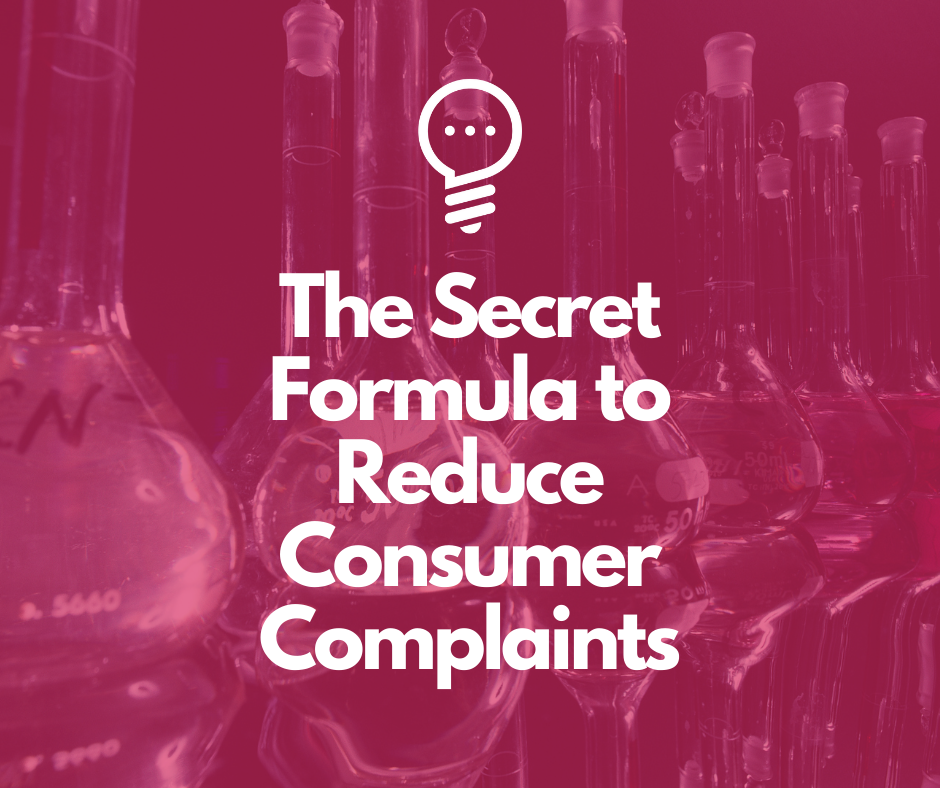Blog
The Secret Formula to Reduce Consumer Complaints

Raise your hand if you’ve ever felt stressed or scared of making a mistake while on a collection call because you’re worried it will result in a complaint or lawsuit.
Spoiler alert: almost everyone who has worked in the ARM industry has had this fear, so you’re definitely not alone.
Before I created The Collection Advantage online training program, I had this fear too. In fact, I had many sleepless nights worrying about the possibilities of my team members or me creating too much conflict, making mistakes, or handling difficult consumer situations poorly.
I want to let you in on a secret: you can turn around almost any difficult situation with a consumer without getting a complaint.
The answer lies in a special formula for handling sensitive or difficult situations with consumers. The great news is, I’m going to share that formula with you today so you can stop stressing over consumer complaints and start focusing on positive outcomes instead.
Before we jump in, let me set the scene:
You’re on a call with the consumer, and they’re beyond the point of frustration—they’re actually angry. Maybe they were angry before the call began. Or maybe your agency did make a mistake. The situation seems unworkable, and you’re terrified that the call is going to escalate into something even worse.
So what do you do?
Time for you to find out.
Let's dive right in with step one.
Step 1: Regroup & Gather Facts
Before you can do anything, you need to get some breathing room from the situation, so tell the consumer, “I need to look deeper into this situation and give you a call back. What is the best number to reach you at?”
Once you’re off the phone, take a moment to regroup and gather the facts of the situation.
Explain the situation to yourself in detail and determine all the important facts. Make sure to include all the account information, a timeline of events, the concerns, or any accusations the consumer is making.
Remember: this is not about dissecting emotions. I’m usually all for labeling a consumer’s emotions, especially since research shows this can be effective. The problem is, when the consumer is already at their boiling point, we don’t want to cause more conflict by worrying too much about the emotional components yet. This step is all about taking a step back and looking at the situation with an objective eye.
Take notes of these details, and move on to step two now that you have a deeper understanding of what is objectively going on.
Step 2: Figure out Where You Want the Call to Go
We’re going to do things seemingly out of order here: before you do any additional planning, make a decision about where you want the call to end up. What solution do you want to reach with the consumer by the end of the call?
In a heated situation with a consumer, the outcome you want is probably pretty simple. For example, you may aim to make sure the consumer doesn’t make a complaint.
Once you have an outcome in mind, it’s time to move on to step three and begin the planning process.
Step 3: Create Your Roadmap
This step is all about reverse-engineering from the solution and creating a roadmap for how you’ll get there.
Start by asking yourself…
"What needs to be true in order to reach this outcome?"
Another way to ask this is, “What needs to happen in order to fix the problem?”
When you ask yourself what needs to happen in order to fix the problem, jot down everything that comes to you in bullet points.
Sometimes you need to ask yourself the question, “What can we do with where we are at and with what we have at our disposal?”
Once you have answers to those questions, you can move on to step four.
Step 4: Create a Script
When you plan out a conversation ahead of time, you cut down on the majority of headaches. After all, when you know what to say, when to say it, and how to say it, you’re leaving less room for mistakes. And the most challenging situations with consumers—especially the ones that may result in a complaint or lawsuit—are the last places we want to make mistakes.
To create a script, make sure to consider what objections the consumer may bring up. That way, you can have responses prepared that will keep you and the consumer in the connection zone from the beginning of the call to the end.
Once you have your script ready, practice it a few times with a colleague if you can, and then call the consumer back, keeping your outcome in mind the entire call.
Goodbye, Sleepless Nights
The Collection Advantage online training program has an entire lesson and worksheet dedicated to this concept. Interested? Follow this link to get started.
If you haven’t already, make sure to reserve your spot at Collector.Live! 2022. I’m going to speak about effective negotiation tactics, and you won’t want to miss it. Register today!
To see this post as it was originally published, visit maryshores.com.




